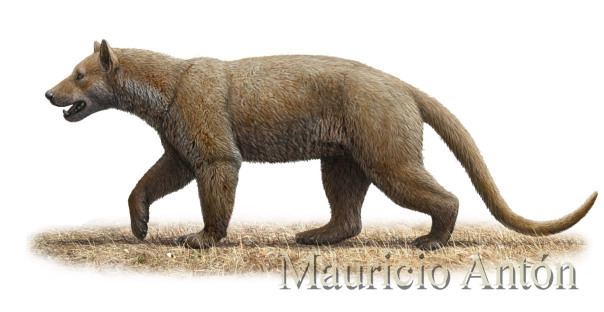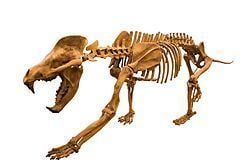Suborder Caniformia Scientific name Amphicyon Order Carnivores | ||
 | ||
Similar Bear dog, Mammal, Daeodon, Hyaenodon, Carnivores | ||
A tribute to amphicyon the bear dog
Amphicyon ("ambiguous dog") is an extinct genus of large carnivorous bone-crushing mammals, popularly known as bear-dogs, of the family Amphicyonidae, subfamily Amphicyoninae, from the Aquitanian Epoch until the early Pleistocene. They ranged over North America, Europe, Asia, and Africa from 16.9—2.6 Ma ago, existing approximately 14.3 million years.
Contents

Morphology

Amphicyon was the typical bear-dog amphicyonid with morphology similar to both bears and dogs. With its robust build and maximum length of 2.5 m (8 ft), the largest Species looked more like a bear than a dog. It had a large heavy tail, thick neck, robust limbs and teeth like a wolf. It was probably an omnivore with a lifestyle comparable to that of the brown bear.
Body mass

A single specimen was examined by Legendre and Roth and estimated to have a body mass of 84.2 kg (190 lb), roughly half that of Ischyrocyon and roughly the same as Epicyon which shared its time period and habitat. A. ingens was much bigger: Sorkin (2008) estimated the largest known specimen (AM 68108) to weigh 600 kg, making it one of the largest known amphicyonids.
Fossil distribution

The earliest occurrences of Amphicyon in North America are from the early to mid-Miocene, found in the Runningwater Formation in Sioux County, Nebraska, and from the lower part of the Troublesome Formation, Colorado (A. galushai, A. frendens, and A. ingens). Although other large amphicyonids from the Miocene of North America have been placed in Amphicyon, many of these carnivores are now placed in other amphicyonid genera. The Amphicyon lineage in the New World is restricted to the above three species (18.8–14.2 Ma). Particularly rich samples of the large North American species of Amphicyon have been found in the Sheep Creek Formation (A. frendens) and Olcott Formation (A. ingens) of central Sioux County, northwest Nebraska. Amphicyon has also been found in France and Spain in Europe. Amphicyon'S youngest range is on the Indian subcontinent, where it disappeared only in the early Pleistocene.
Species

Amphicyon major lived from 16.9–9.0 Ma, approximately 7.9 million years. Specimens have been found in across Europe and in western Turkey. The species was named by De Blainville in 1841. A. major was large in size, comparable to a modern lion or tiger. The estimated mass of A. major is around 180 kg (397 lb) with the functions derived for limb bones and craniodental measurements.
Amphicyon giganteus was a widespread European species that lived during the early burtigalian to early Langhian, approximately from 20.4–15.9 Mya, with possible material from Namibia. The species was first described in 1884 by Kaup. A specimen of Iberotherium rexmanueli zbyszewskii with teeth marks from A. giganteus was found in Portugal. It is unknown if the young Iberotherium was attacked or the carcass found and scavenged. The find was described by paleontologists Antunesa et al. in 2006.
Amphicyon galushai represents the first occurrence of Amphicyon in North America, from approximately 18.8–17.5 Mya during the early Hemingfordian. Described by Robert M. Hunt Jr. in 2003, it is mostly known from fossils found in the Runningwater Formation of western Nebraska, a complete adult skull, a partial juvenile skull, 3 mandibles and teeth and postcranial elemenents representing least 15 individuals. In addition there is a skull fragment from the Troublesome Formation of Colorado. It is considered ancestral to the late Hemingfordian species, A. frendens.
Amphicyon frendens lived during the late Hemingfordian, 17.5–15.9 Mya, The species was originally described by W. Matthew in 1924 from specimens found in the middle member of the Sheep Creek Formation, Sioux County, Nebraska. A. frendens specimens have since been found at sites in Harney and Malheur Counties, Oregon. A specimen examined by S. Legendre and C. Roth in 1988 yielded an estimated body mass of 135.6 kg (300 lb), similar to that of Ischyrocyon, Amphicyon galushai and its borophagine competitor, Epicyon, with which it coexisted.
Amphicyon ingens lived during the early to middle Barstovian, 15.8–14.0 Mya. The species was originally described by W. Matthew in 1924 from specimens found in the Olcott Formation, Sioux County, Nebraska. Specimens attributed to this species have since been found in California, Colorado, and New Mexico.
Amphicyon palaeindicus is known from the Bugti Hills in Pakistan. It was first described by Richard Lyddeker in 1876. The exact age of the fossil sites it was recovered from is unclear, though they seem to range from the late Oligocene to the late Miocene. Its status as an actual species is unclear, as nearly all remains attributed to Amphicyon in the region were attributed to it.
Amphicyon lyddekeri is known from the Dhok Pathan horizon in Pakistan. It was originally described by Pilgrim in 1910 and attributed to its own genus, Arctamphicyon. However, the differences between "Arctamphicyon" and Amphicyon may ultimately be negligible, and it is most likely part of the genus. With the Dhok Pathan deposits dating to the early Pleistocene, Amphicyon lydekkeri is the youngest amphicyonid known.
